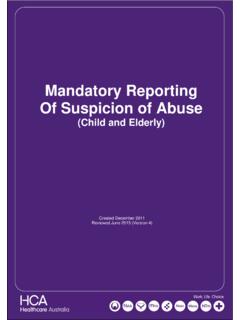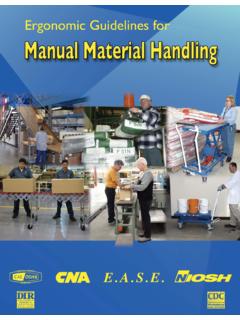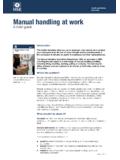Transcription of Manual Handling - Healthcare Australia
1 The HCA Way Manual Handling Created September 2009 Reviewed October 2017 (Version 10) Page 2 Level 1 Document Manual Handling Healthcare Australia endorses a no lift policy and bases its training on the ANMF No lift, no injury method (Bonner & Pockock 2004). Following successful completion of this theoretical package and multi-choice assessment quiz you must attend a hour practical assessment or supply valid evidence of completion from elsewhere. Page 3 Level 1 Document Manual Handling Manual Handling is an activity that is simply part of everyday life; it cannot be avoided so we must do our best to make sure that we are using the safest techniques possible to avoid injury.
2 It is defined as any activity that requires an individual to exert a force to push, pull, lift, carry, lower, restrain any person, animal or thing. As a nurse or a personal care worker, this means that Manual Handling is more than just moving and assisting our clients. The majority of tasks we complete in our day include some form of Manual Handling . Manual Handling is described as any activity, which requires a person to exert force in order Lift Lower Push Pull Carry Move Hold, or Restrain Manual Handling Injuries Using unsafe Manual Handling techniques ( incorrect lifting techniques, incorrect posture and moving items that are too heavy for a single person) can cause a variety of musculoskeletal injuries which can impact upon the person s ability to work and their quality of life.
3 Musculoskeletal injuries that may occur from Manual Handling injuries can include: Muscle sprains and strains; Ligament or tendon damage; Prolapsed intervertebral disks; Tendonitis of the shoulders/elbows; Abdominal hernias; Nerve damage. 4 Legislative Framework The Act: The National Work Health and Safety (WH&S) Act was introduced in 2012. WH&S Regulations are specific to their State. Links to these different Acts can be found through However, they all share common elements focusing on Hazard Identification, Risk Assessment and Risk Control. These Regulations provide legislative guidelines for Manual Handling compliance within workplaces.
4 They provide the framework of design, consultation, assessment, control and training to be implemented in the workplace. Code of Practice ( Manual Handling ) A guide towards assisting the implementation of the Manual Handling regulations The HCA Way Manual Handling By incorporating the ANMF No Lift No Injury approach, the HCA WAY aims to reduce the risk of injury by: Eliminating Manual lifting of people in all situations apart from those which are life threatening or exceptional circumstances; Maintaining and promoting client independence; Providing assistance if it doesn t involve lifting most or all of a client s weight.
5 And, Providing support to clients unable to lift themselves, by using lifting aids including mechanical lifting machines, hoists and rigid or fabric sliding devices. 5 Industry Guidelines ( Manual Handling ) Some industries that have been identified as being particularly at risk in particular sectors have guidelines or competencies developed in that sector. In aged care, there are Manual Competencies for Nurses. Employee s Responsibilities in Manual Handling As an employee you have a legal responsibility to ensure the safety of yourself and others in the workplace. According to the 2011 Work Health & Safety (WH&S) Act, a worker should: Take reasonable care to ensure the health and safety of yourself and others including clients and other workers; Report any and all incidents or hazards associated with Manual Handling immediately to the shift supervisor (including any changes to patient care plans); ALWAYS follow safe Manual Handling practices and techniques and use equipment according to the workplace training that you have received; and Be free from the influence of drugs and/or alcohol whilst at work.
6 6 Understanding Hazard and Risk HAZARDS are factors in the workplace that have the potential to cause injury or ill-health and can apply to the methods being used to perform a task, the use, storage or transit of substances, general workplace practices and procedures and use of is the likelihood of a particular hazard causing an injury. Where possible, the focus should be on minimizing the risk of injury, if not eliminating the risk completely. Hazard Management 1) Hazard Identification: Possible hazards are identified through consultation with employees, direct observation, client assessments and review of injury records.
7 2) Risk Assessment: Once potential hazards are identified, the evaluation process begins to assess the likelihood and the consequence of injury or illness as a result of exposure to the hazard. Assessments include actions and movements, working posture and position, characteristics of loads and equipment. 3) Risk Control: After the Risk Assessment, the workplace must consider how the hazard can be eliminated or minimize the risk of injury or illness (where elimination is not possible). 7 The Hierarchy of Risk Control 1) Eliminate the task: Remove the hazardous work process/task from use completely.
8 2) Substitute the task: Substitute the hazardous work process/task to one that is safer for both the workers and clients. 3) Isolate the task: Separate the people at risk from the hazard by isolating it. 4) Engineer controls: Use engineering controls to reduce risk by making physical changes to the equipment used. 5) Administrative controls: Use administration controls to reduce risk increase job variety and rotation, provide training in the safe use of equipment and techniques, regular maintenance of equipment. 6) Personal Protective Implement the use of personal protective equipment (PPE) Equipment: whilst completing hazardous work processes/tasks.
9 Note: The use of PPE to control hazards should only be used as a last resort. 8 The Importance of Correct Spine Alignment The spine is central to our whole body s function, providing a stable base for our limbs and head and protecting our nervous system from harm. Correct spine alignment is the best way of maintaining spinal health. By using correct spine alignment during your daily activities, whether you are sitting, standing, lifting or bending, you are minimising the risk of injury to your back. It also allows our muscles to work with minimal effort and places the spine in its most efficient and powerful position.
10 Ongoing deviations from correct spinal alignment (or the natural S curvature of the spine), such as prolonged slouching or arching of the back, result in headaches, chronic neck and back pain, pinched nerves, muscle imbalances and degeneration of the spinal discs. Establishing Correct Spine Alignment To achieve correct spine alignment whilst standing you need to imagine a straight line running down through your body. Imagine there is a string attached to the crown of your head stretching you tall. Remember to tuck your chin slightly. The string should then travel down through the crown of your head, the ear, the tip of the shoulder, the hip joint, the back of the knee cap and in front of the ankle bone.

















